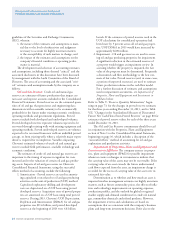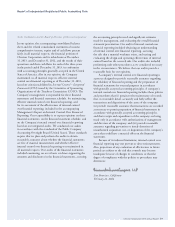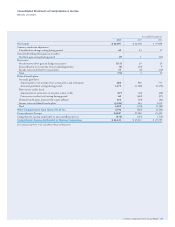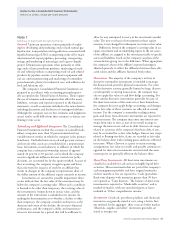Chevron 2013 Annual Report Download - page 28
Download and view the complete annual report
Please find page 28 of the 2013 Chevron annual report below. You can navigate through the pages in the report by either clicking on the pages listed below, or by using the keyword search tool below to find specific information within the annual report.
Management’s Discussion and Analysis of
Financial Condition and Results of Operations
26 Chevron Corporation 2013 Annual Report
in the discount rate applied to the company’s primary
U.S. pension plan, which accounted for 59 percent of the
companywide pension obligation, would have reduced
the plan obligation by approximately $345 million, which
would have increased the plan’s overfunded status from
approximately $0.4 billion to $0.7 billion.
For the company’s OPEB plans, expense for 2013 was
$218 million, and the total liability, which reected the
unfunded status of the plans at the end of 2013, was $3.1
billion. For the main U.S. OPEB plan, the company used a
3.9 percent discount rate to measure expense in 2013, and a
4.7 percent discount rate to measure the benet obligations at
December 31, 2013. Discount rate changes, similar to those
used in the pension sensitivity analysis, resulted in an imma-
terial impact on 2013 OPEB expense and OPEB liabilities
at the end of 2013. For information on the sensitivity of the
health care cost-trend rate, refer to page 59 in Note 21 under
the heading “Other Benet Assumptions.”
Dierences between the various assumptions used to
determine expense and the funded status of each plan and
actual experience are included in actuarial gain/loss. Refer
to page 58 in Note 21 for a description of the method used
to amortize the $5.2 billion of before-tax actuarial losses
recorded by the company as of December 31, 2013, and an
estimate of the costs to be recognized in expense during
2014. In addition, information related to company contribu-
tions is included on page 61 in Note 21 under the heading
“Cash Contributions and Benet Payments.”
Contingent Losses Management also makes judgments
and estimates in recording liabilities for claims, litigation,
tax matters and environmental remediation. Actual costs can
frequently vary from estimates for a variety of reasons. For
example, the costs for settlement of claims and litigation can
vary from estimates based on diering interpretations of laws,
opinions on culpability and assessments on the amount of
damages. Similarly, liabilities for environmental remediation
are subject to change because of changes in laws, regulations
and their interpretation, the determination of additional
information on the extent and nature of site contamination,
and improvements in technology.
Under the accounting rules, a liability is generally
recorded for these types of contingencies if management
determines the loss to be both probable and estimable.
ecompany generally reports these losses as “Operating
expenses” or “Selling, general and administrative expenses”
on the Consolidated Statement of Income. An exception to
this handling is for income tax matters, for which benets are
recognized only if management determines the tax position
is“more likely than not” (i.e., likelihood greater than 50per-
cent) to be allowed by the tax jurisdiction. For additional
discussion of income tax uncertainties, refer to Note 23
beginning on page 62. Refer also to the business segment
discussions elsewhere in this section for the eect on earnings
from losses associated with certain litigation, environmen-
tal remediation and tax matters for the three years ended
December 31, 2013.
An estimate as to the sensitivity to earnings for these
periods if other assumptions had been used in recording
these liabilities is not practicable because of the number of
contingencies that must be assessed, the number of underly-
ing assumptions and the wide range of reasonably possible
outcomes, both in terms of the probability of loss and the
estimates of such loss.
New Accounting Standards
Refer to Note 18, on page 54 in the Notes to Consolidated
Financial Statements, for information regarding new
accounting standards.
























